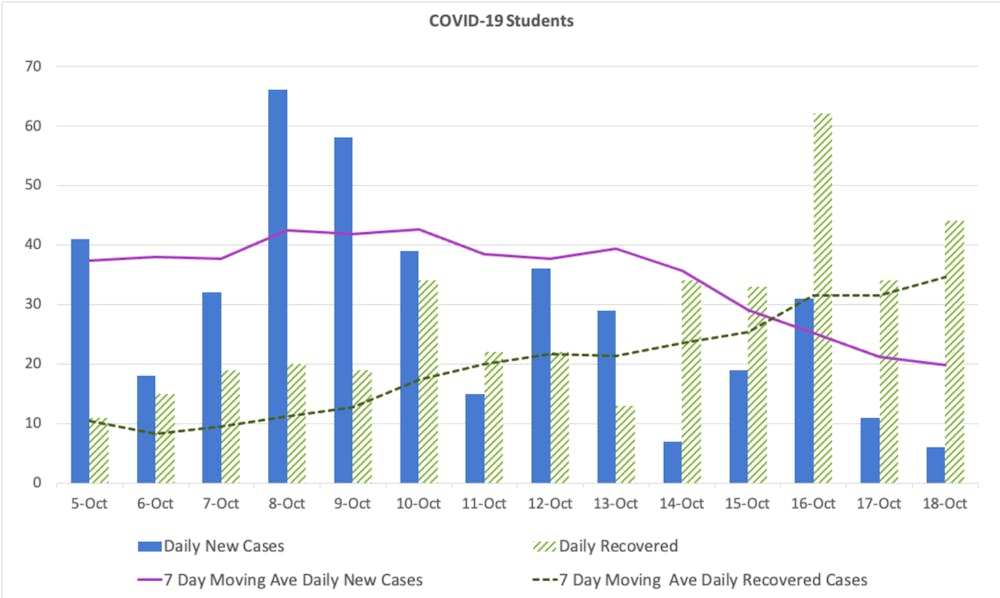Miami University’s COVID-19 Oxford campus dashboard has been active for nearly two months. But some students have raised concerns about the information provided by Miami.
As of Oct. 18, Miami’s dashboard reported 2,162 cumulative COVID cases. Butler County reported 7,702 confirmed cases as of Oct. 16. That means Miami’s Oxford campus makes up 28% of Butler County’s confirmed cases.
The dashboard was originally released to the Miami community on Aug. 21. It displays a graph of the positive and recovered cases of COVID-19 on Miami’s Oxford campus.
It also reports a seven-day moving average of both active and recovered cases.
While the dashboard provides data for 14 previous days from the last update, information prior to that is not available.
Miami’s University Communications and Marketing (UCM) department is responsible for updating the dashboard regularly as cases are reported by Butler County Health and TriHealth.
The director of UCM, Jaime Hunt, forwarded The Miami Student’s (TMS) questions to Carole Johnson, interim director of university news and communications.
When asked why only two weeks at time are displayed and if there is any way to access the averages or case numbers from the past, Johnson wrote in an email to TMS that public health guidance suggests those infected with COVID-19 are clear 14 days after showing symptoms.
“The COVID-19 dashboard allows us to better understand and respond to active infections by showing the cases diagnosed over the previous two weeks,” Johnson wrote.
The dashboard also shows the residence hall color-coding system and updates the residence halls’ statuses daily.
However, the dashboard does not indicate exactly how many positive cases have been reported for each residence hall. It also does not differentiate between on-campus and off-campus cases.
For sophomore Sam Flake, the dashboard is never far from her search history. However, she said there are some changes she’d like to see to the information board.
Enjoy what you're reading?
Signup for our newsletter
Flake lives off-campus and says she visits the website every day or every other day. She said she would like more detail about the number of cases in each hall.
“I think it's pretty vague,” Flake said. “It doesn't give you a whole lot of information. It'll tell you how many cumulative cases there are, but it doesn't go into depth of how many cases are in each dorm.”
Sophomore Kasey McDaniel lives on-campus and visits the site periodically but mostly to check her friends’ dorms. She said the level a dorm is at could determine who she hangs out with.
“I had a friend whose building reached Level 3,” McDaniel said. “He kept testing negative so he was fine, but we didn't hang out for a period of time until his building went back down to Level 2.”
The dashboard breaks down residence hall floors by their color-coded level, but it does not specify which floors of Level 4 dorms are actually under the remain-in-room advisory. McDaniel said that would be helpful information to add to help her determine where to spend her time.
Flake said she’d also like to see how many cases are on campus or off campus.
Johnson wrote that determining whether positive cases are on or off campus could delay the dashboard’s update times.
“Our focus has been on providing a more detailed look at the specific residence halls with our color coding chart,” Johnson said. “The color-coding system allows us to identify potential outbreaks in the residence halls so we can implement additional measures to slow the spread of the virus.”
Flake said she understands some information might be delayed.
“In a perfect world, I'd like it immediately,” Flake said. “But I know that's unrealistic. So I'd like to at least have the number of cases as soon as possible. Then, at least within a few days, know where [the cases] came from.”
As of Oct. 18, Miami reports 19 new daily cases for their seven-day moving average. The university also reported 408 active cases as of the same date.
“Our seven-day average has remained fairly steady at 30 to 40 cases,” Johnson wrote. “Of course, we want that number to be as low as possible. To slow the spread of COVID-19, we need 100% compliance with our mandates: wear a mask indoors and out, maintain physical distancing of six feet or more, avoid gathering in large groups, wash your hands frequently, and follow the Remain-in-Room plan if your residence hall floor is affected.”




